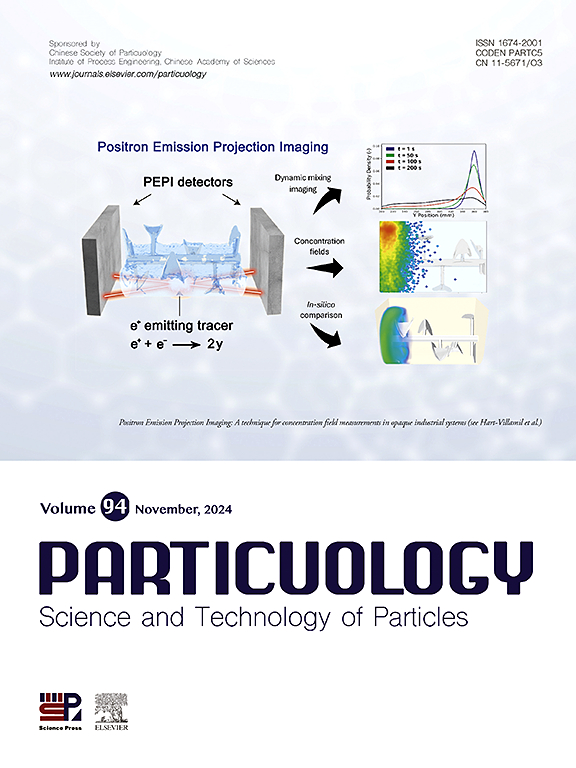Particle size distribution of submicron particulate matter from coal/biomass combustion under different conditions: A comparison of modeling and experimentation
IF 4.1
2区 材料科学
Q2 ENGINEERING, CHEMICAL
引用次数: 0
Abstract
Coal/biomass combustion is a major source of submicron particulate matter (sub-PM), with mineral substances in the fuels playing a key role in the formation and growth of these particles. In this study, the temporal evolution of sub-PM is predicted by simulating coal/biomass combustion under different temperature, atmosphere, species, particle size and density conditions by using nucleation, condensation, coagulation and deposition sub-models. Compared with experimental data, the results show that the amount of sub-PM generated from pulverized coal combustion increases with higher temperatures and oxygen concentrations, and lignin (LN) produces the highest emission of sub-PM among different biomass types. The peak particle size distribution (PSD) of sub-PM across different experimental conditions is mainly centered around 0.1–0.2 μm. The values of relative error are below 20% and even below 10%, indicating that the model is in good agreement with the experimental data. Subsequently, the effects of pulverized coal size and coal density on the PSD of sub-PM are predictively simulated by the verified model, the findings indicate that both of the peak PSD are among 0.08–0.23 μm, the emission amount of sub-PM negatively relate to coal size and coal density.
不同条件下煤/生物质燃烧亚微米颗粒物的粒径分布:模型与实验的比较
煤/生物质燃烧是亚微米颗粒物(sub-PM)的主要来源,燃料中的矿物质在这些颗粒物的形成和生长中起着关键作用。本研究采用成核、凝结、凝聚和沉积四个子模型,模拟煤/生物质在不同温度、大气、物种、粒径和密度条件下的燃烧过程,预测了亚pm的时间演变。结果表明,煤粉燃烧产生的亚pm随着温度和氧浓度的升高而增加,不同生物质类型中木质素(LN)产生的亚pm排放量最高。不同实验条件下,亚pm的峰值粒径分布(PSD)主要集中在0.1 ~ 0.2 μm附近。相对误差值在20%以下,甚至在10%以下,表明模型与实验数据吻合较好。利用验证的模型预测了煤粉粒度和煤粉密度对细颗粒物PSD的影响,结果表明,细颗粒物的峰值PSD均在0.08 ~ 0.23 μm之间,细颗粒物的排放量与煤粉粒度和煤粉密度呈负相关。
本文章由计算机程序翻译,如有差异,请以英文原文为准。
求助全文
约1分钟内获得全文
求助全文
来源期刊

Particuology
工程技术-材料科学:综合
CiteScore
6.70
自引率
2.90%
发文量
1730
审稿时长
32 days
期刊介绍:
The word ‘particuology’ was coined to parallel the discipline for the science and technology of particles.
Particuology is an interdisciplinary journal that publishes frontier research articles and critical reviews on the discovery, formulation and engineering of particulate materials, processes and systems. It especially welcomes contributions utilising advanced theoretical, modelling and measurement methods to enable the discovery and creation of new particulate materials, and the manufacturing of functional particulate-based products, such as sensors.
Papers are handled by Thematic Editors who oversee contributions from specific subject fields. These fields are classified into: Particle Synthesis and Modification; Particle Characterization and Measurement; Granular Systems and Bulk Solids Technology; Fluidization and Particle-Fluid Systems; Aerosols; and Applications of Particle Technology.
Key topics concerning the creation and processing of particulates include:
-Modelling and simulation of particle formation, collective behaviour of particles and systems for particle production over a broad spectrum of length scales
-Mining of experimental data for particle synthesis and surface properties to facilitate the creation of new materials and processes
-Particle design and preparation including controlled response and sensing functionalities in formation, delivery systems and biological systems, etc.
-Experimental and computational methods for visualization and analysis of particulate system.
These topics are broadly relevant to the production of materials, pharmaceuticals and food, and to the conversion of energy resources to fuels and protection of the environment.
 求助内容:
求助内容: 应助结果提醒方式:
应助结果提醒方式:


